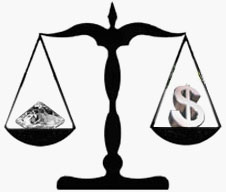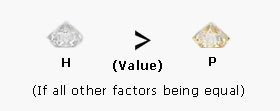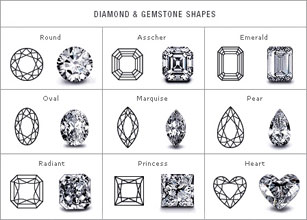| BUYING GUIDE | |||||||||||||||
What Exactly is a Diamond?
A symbol of wealth, purity and love, a diamond leaves no one unmoved.
In mineralogy, diamond is an extremely hard, highly refractive crystalline form of carbon that is usually colorless and can be usedin abrasives, and other applications. Diamond is carbon in its most concentrated form, often occurring as octahedrons with rounded edges and curved surfaces.
Diamonds are formed at incredible depths of the earth, between 150 and 300 km below the surface and under conditions of extreme temperature and pressure. They are most commonly found in volcanic breccias and in alluvial deposits, pushed up by a kind of volcanic eruption through volcanic pipes of diamond bearing rock such as kimberlite. With gradual erosion, kimberlite chimneys were exposed at the earthís surface.
Read more on 4C's
The first factor of the 4C's that most people learn about is carat - the weight of the diamond, which is also the best indication of a diamond's size.
Let's take a look at carat in detail, to understand how it affects the price.
A carat is the standard unit of weight for diamonds. One carat equals 1/5 of a gram, or .007 of an ounce. In other words... there are 5 carats in 1 gram and 142 carats in 1 ounce.
You also may have heard about "points". This does not refer to the number facets on a diamond, but rather to its weight. Just like one pound is divided into 16 ounces, one carat is divided into 100 points -- so each point is 1/100th of a carat. A "10-point" diamond weighs 1/10th of a carat, and a 50-point stone weighs one-half carat.

How it affects the price?
Carat weight has a great deal of influence on the price of a diamond. All other factors being equal, as weight increases, rarity and value of a diamond will also increase. For instance, one diamond weighing 2 carats will always cost much more than two diamonds of the same quality weighing 1 carat each.
So, if size is an important factor for you or the person you are buying for, less emphasis can be placed on the other C's to choose a larger diamond.

Clarity is one of the important factors in diamond pricing, along with color. While the color does affect a diamond's appearance, obvious inclusions (often called "flaws") may distract the recipient's eye from a stone's overall beauty.
Let's take a look at clarity in detail to understand how it affects the price.
Clarity greatly varies from one diamond to another, and no two are exactly alike. Diamonds are graded and identified uniquely according to the type and number of inclusions present in them.

| FL | Flawless | No internal or external inclusions of any kind visible under 10x magnification to a trained eye, the most rare and expensive of all clarity grades. |
| IF | Internally Flawless | No internal inclusions visible under 10x magnification to a trained eye, but there may be some tiny external irregularities in the finish. |
| VVS-1 | Very Very Slightly Included 1 | Usually just one tiny inclusion visible only to a trained eye under 10x magnification. |
| VVS-2 | Very Very Slightly Included 2 | Tiny inclusions visible only to a trained eye under 10x magnification. |
| VS-1 | Very Slightly Included 1 | Very small inclusions visible with 10x magnification. |
| VS-2 | Very Slightly Included 2 | Several very small inclusions visible with 10x magnification. |
| SI-1 | Slightly Included 1 | Small inclusions visible with 10x magnification. |
| SI-2 | Slightly Included 2 | Several small inclusions visible with 10x magnification. |
| SI-3 | Slightly Included 3 | Inclusions that may be visible to the naked eye for a trained observer. |
| I-1 | Included 1 | Flaws that are visible to the naked eye. |
| I-2 | Included 2 | Many flaws clearly visible to the naked eye that also decrease the brilliance. |
| I-3 | Included 3 | Many flaws clearly visible to the naked eye which decrease the brilliance and compromise the structure of the diamond, making it more easily cracked or chipped |
How it affects the price?
All other factors being equal, as the grading decreases the price decreases exponentially. This is because diamonds with greater quality (correspondingly with lesser inclusions) are that much rarer. Along with the type and number of inclusions, their position also makes an impact on the value and brilliance of a diamond. Inclusions at the edges of a diamond can be hidden by the setting selected. However, inclusions in the middle of a diamond may significantly affect itís radiance and beauty and so itís value.
Color in the diamond trade usually refers to the amount of yellow in a stone, but can also indicate brown or gray and sometimes all three. The most treasured diamond color is actually the "colorless" grade -- one without any color at all.
Let's take a look to cover color in detail to understand how it affects the price.
Colorless diamonds are the most desirable since they allow the most refraction of light (sparkle). The light that enters a diamond is split into the rainbow spectrum of colors, which are reflected throughout the gem. These colorful splashes are collectively called fire. Entirely colorless diamonds will exhibit fire in all the colors of the rainbow. The more color a diamond has, the lesser colors there will be in the fire which itself will be slightly dimmed. Off white diamonds absorb light, inhibiting brilliance.
Diamonds are also found in a variety of other colors such as blue, green, yellow, orange, pink or, rarest of all red. Diamonds with distinct tints other than those of the normal color range are classified as fancy colors. All such colored diamonds are very rare and valued.
Diamonds are graded on a color scale, which ranges from D (colorless) to Z.

| D | Absolutely colorless | The highest color grade, which is extremely rare. |
| E | Colorless | Only minute traces of color can be detected by an expert gemologist. A rare diamond. |
| F | Colorless | Slight color detected by an expert gemologist, but still considered a "colorless" grade. A high-quality diamond. |
| G-H | Near-colorless | Color noticeable when compared to diamonds of better grades, but these grades offer excellent value. |
| I-J | Near-colorless | Color slightly detectable. An excellent value. |
| K-M | Faintly tinted | Usually yellow. Tint can be seen with the naked eye. |
| N-Z | Tinted | Usually yellow, may progress to brownish. Tint visible to the naked eye, even when mounted. |
How it affects the price?
All other factors being equal, the more colorless a diamond, the higher its value. The color results from the presence of certain elements in the surroundings of the diamond crystal during its formation stages. The formation process of a diamond ensures that only a few, rare diamonds are truly colorless. Fancy color diamonds do not follow this rule. These diamonds, which are very rare and very expensive, can be of any color including red, blue, and green, unlike white diamonds, the more intense the color, the more valuable the stone.

Many people confuse cut with the shape of a diamond. The shape you select is a matter of individual taste, and today your choice is only limited by the skill and imagination of the craftsman.
Let's take a look to cover cut in detail to understand how it affects the price.
The cut is the most critical component of the 4C's, since the value of two diamonds with exactly the same carat weight could vary by up to 50% depending on the quality of cut. Just as fine cloth needs an expert tailor to create a quality garment, the diamond cutter controls the fire and brilliance of a diamond.
Cut of a diamond refers to how well a stone is cut and faceted to bring out the full beauty of the rough crystal. Good proportions, symmetry and polish affect the beauty of a diamond much more than perfect color or clarity.
The cutting grade is determined by the diamond cutter's effort to maximize the refraction of light during every stage of the fashioning process. Most brilliant-cut or fancy-shaped diamonds possess fifty-eight carefully angled flat surfaces, called facets, whose placement will affect the fire, brilliance and ultimate beauty of your diamond.
Proportion is the single most important factor, because it determines the flow of light more than other quality factors. Proportions that are too deep or too shallow both allow light to leak out the bottom and lessen the amount of light that strikes your eye.

Because cut is so important, several grading methods have been developed to help consumers determine the cut of a particular diamond. In general, these grades are: Ideal, Premium, Very Good, Good, Fair & Poor Selecting the grade of cut is really a matter of preference. To make the best selection, you need to understand the various grades. Please note that the descriptions below are general guidelines.
Ideal Cut
This cut is intended to maximize brilliance. Ideal cut diamonds generally have smaller tables, complemented by a great deal of light dispersion, or fire. GIA's Excellent stones, as well as AGS 000 stones fall into this category. This category applies only to round diamonds and most valued.
Premium
Also intended to provide maximum brilliance and fire, premium cut diamonds can be generally found at slightly lower price points than Ideal cut diamonds.
Very Good
These diamonds reflect most of the light that enters, creating a good deal of brilliance. With these diamonds, the cutters have chosen to stray slightly from the preferred diamond proportions in order to create a larger diamond.
Good
Diamonds that reflect much of the light that enters them. Such stones result from the cutter's choice to create the largest possible diamond from the original rough crystal, rather than cutting extra weight off to create a smaller Premium quality diamond. Diamonds in this range offer an excellent cost-saving to customers who want to stay in a budget without sacrificing quality or beauty.
Fair & Poor
A diamond graded as fair or poor reflects only a small proportion of the light that enters it. Often these stones are bought and re-cut into Ideal or Premium cuts, such that a more brilliant stone is produced by sacrificing some weight.
How it affects the price?
With all the attention given to the 4C's of diamond grading and evaluation (cut, color, clarity and carat weight), the cut is actually the single greatest factor in the beauty. Color, shape, clarity and carat weight determine the rarity and value of a diamond, but the cut determines its beauty. Without any cutting, bruting, faceting or polishing, a rough diamond might very well go unnoticed in a pile of rocks. It is the diamond's unique combination of durability, rarity and potential beauty that makes it so valuable.




